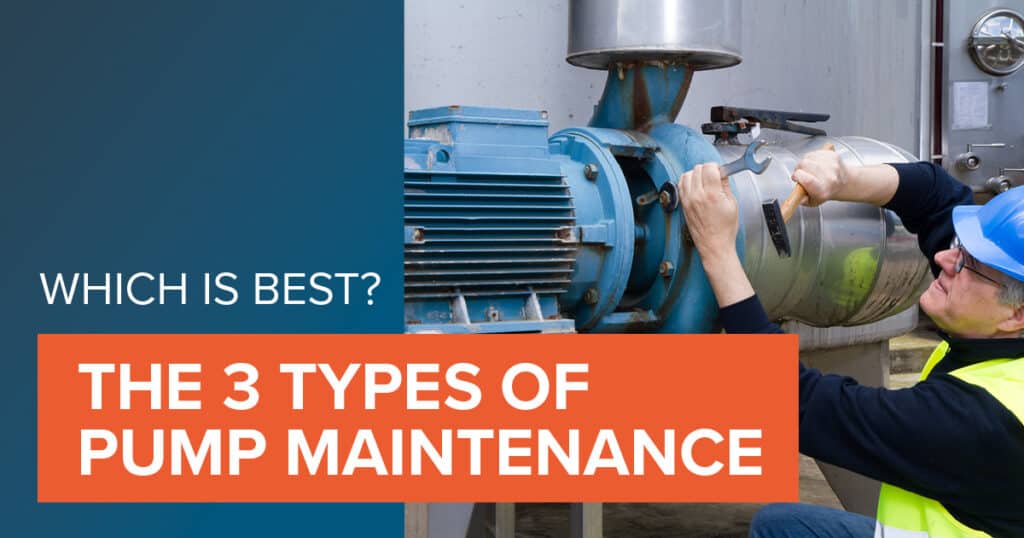When it comes to maintaining your pump equipment and keeping your system dialed in for optimized performance, you have to make choices. How you approach your maintenance needs can make a significant difference. A proper plan can extend the life span of the equipment, reduce the risk of failures and extended downtime, and improve various aspects of system performance like energy efficiency.
In our experience, there are usually three types of pump maintenance planning. Which approach best describes your operation? Which is ultimately the best long-term solution?
- Reactive Pump Maintenance
The concept of reactive pump maintenance is simple. You wait until equipment or system performance problems occur. Then you address the issue with maintenance or repairs. In some cases, this approach is unavoidable. Unexpected things can and will happen, and you are forced to take emergency action. In general, however, this is not an excellent maintenance plan for what should be routine maintenance or repair tasks. You find yourself shutting down at random intervals as you deal with issues that come up. You also have no expectations for how much the repairs may cost or how long your equipment will be shut down. You are basically “winging it” and reacting to situations as they arise. If this describes your operation, it’s time to rethink your pump maintenance strategy.
- Proactive Pump Maintenance
A proactive pump maintenance plan is an actual “plan” that utilizes scheduled maintenance requirements. It allows you to stick with a routine and perform necessary maintenance tasks according to a calendar or other measured intervals. It’s like getting your car’s oil changed and tires rotated every 5,000 miles. You can stick to a predetermined plan and schedule.
Obviously a proactive maintenance schedule is generally a more effective approach than reactive pump maintenance. However, this strategy also has a few inherent flaws. It doesn’t necessarily account for unexpected equipment issues that can happen at any time—no matter how rigidly you stick to your schedule. You may still find yourself dealing with reactive shutdowns and repairs. A quality maintenance schedule should include proper inspections, along with replacing standard worn parts and degraded lubrication. It can be easy to get stuck in a routine and not identify other problems that develop within the system. It is a more proactive approach, and issues may be caught and prevented. Unfortunately, it is not completely foolproof.
- Predictive Pump Maintenance
Last, there is predictive pump maintenance. This approach uses sensors, data analysis, and advanced monitoring equipment to continuously track key performance indicators within your equipment. Factors like vibration, speed, temperature, alignment, pressure, and flow rate can be measured and analyzed in real time. Any slight irregularities or potential issues can be identified immediately. Then they can be addressed through maintenance, repairs, and system configuration adjustments. You can catch problems long before they become major concerns. You can know exactly when specific maintenance tasks need to be performed. You can keep your pump system running optimally at all times. Predictive maintenance can save you time and money while improving safety, environmental protection, and other critical aspects of operation.
If you only had to choose one approach to pump maintenance, predictive maintenance is your best bet. It may require some investments up front to install the right data collection equipment and monitoring software. However, it is well worth it as a long-term solution to pump maintenance.
The Power of Predictive Maintenance
The truth is a superior pump system maintenance plan likely will involve all three of these approaches. Predictive maintenance can drastically reduce the need for reactive maintenance, but your operators still need to be properly trained for emergency troubleshooting and repairs in case something unexpected happens. Predictive maintenance also can help you dial in the more scheduled aspects of your maintenance plan. You will know through data analysis exactly when certain tasks need to be performed. Routine inspections are always a sound idea to implement, no matter how great your predictive maintenance system is.
To learn more about predictive maintenance and how to implement the best preventative pump maintenance strategies for your specific equipment and application, contact DXP Pacific today. We can optimize your system through effective pump management services.

